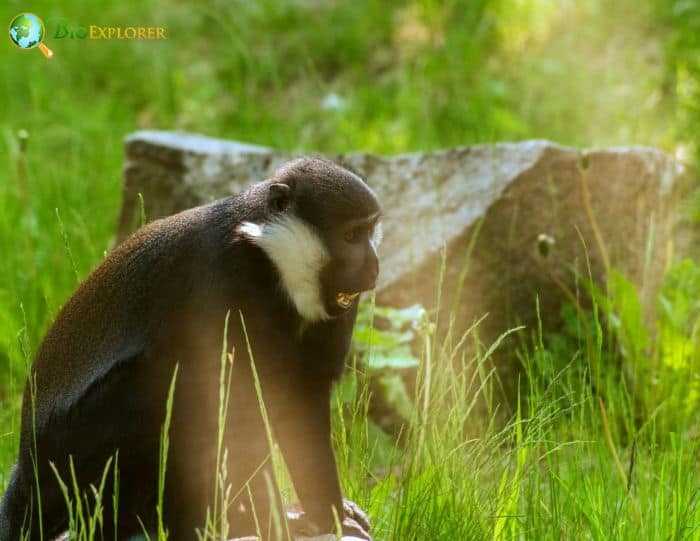
| Animalia | Primates | Cercopithecidae | Allochrocebus | Allochrocebus lhoesti |


- Common Name: L’Hoest’s Monkey
- Taxonomy Classification Year: 1899
- Monkey Size: 31.7 to 68.6 cm (12.48 to 22.01 in)
- Skin Color(s): Dark gray
- Habitat: Forest, rainforest, mountains
- Diet: Omnivorous
- Native Countries: Democratic Republic of Congo
L’Hoest’s Monkey Distribution
L’Hoest Monkey Characteristics
The L’Hoest monkey[1] (Allocrocebus lhoesti), or mountain monkey, is a vervet monkey found in the upper eastern Congo Basin.
- L’Hoest monkeys are showy great apes with long limbs and long tail. L’Hoest monkeys are primarily covered in short dark gray fur and have a large brown saddle pattern on their backs.
- There is also a distinctive large patch of fluffy white fur from the throat on the head sides, almost to the ears.
- Their limbs and abdomen are black. Their face is mostly dark, with paler pinkish-white areas around the eyes and nose.
- Their long tail is medium gray, blacker near the tip, and is often held with the tip curling forward. Their eyes are bright orange.
- In males, the scrotum is light blue, but otherwise, both sexes are similar in coloration.
- L’Hoest’s monkeys have narrow legs that help them walk on the ground.
What Do L’Hoest’s Monkeys Eat?

According to the African Journal of ecology, the L’Hoest’s Monkeys consume African Nutmeg (Pycnanthus angolensis) and Umbrella Tree (Musanga cecropioides)[¶].
What Eats L’Hoest’s Monkeys?

Leopards (Panthera pardus) are the primary predators of L’Hoest’s Monkeys in the wild[§].
L’hoest Monkey Facts

- L’Hoest monkeys sometimes flee from predators while on the ground, which requires coordination. However, the form of this coordination is unknown.
- When females are ready to mate, they rotate their hindquarters toward a male, known as presenting.
- They can nod their heads, which is often done with staring eyes and open mouths and is also a manifestation of threat.
- L’Hoest monkeys live in relatively small groups, are dominated by females, and have only one male.
- If they are alarmed or see that they are being watched, they will run away and take refuge in the trees, then remain very still.

Suggested Reading: Types of Apes List
Cite This Page
APA7MLA8Chicago
BioExplorer.net. (2025, September 12). L’hoest Monkey. Bio Explorer. https://www.bioexplorer.net/animals/mammals/apes/lhoest-monkey/.
BioExplorer.net. "L’hoest Monkey" Bio Explorer, 12 September 2025, https://www.bioexplorer.net/animals/mammals/apes/lhoest-monkey/.
BioExplorer.net. "L’hoest Monkey" Bio Explorer, September 12 2025. https://www.bioexplorer.net/animals/mammals/apes/lhoest-monkey/.











